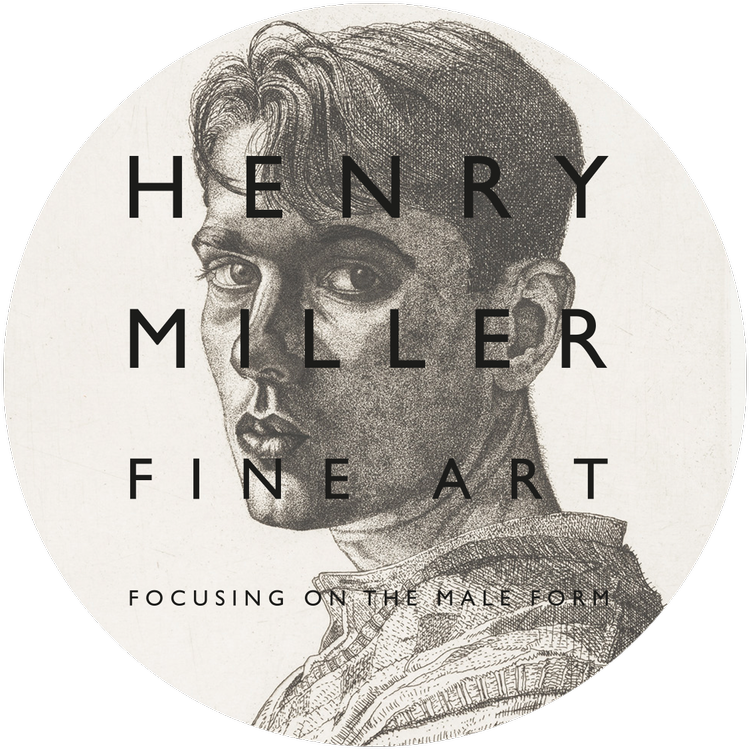If you go into any art dealer in Paris, look at any auction of works on paper, or indeed, visit Henry Miller Fine Art, it is impossible not to notice the number of 18th and 19th century drawings of scantily clad and nude figures for sale. Most, if not all, will be of men; usually completely naked men in a variety of poses and stances. It would be easy to think that artists prior to the birth of modern art in the early 20th century, were obsessed with drawing the naked male form. Given the way that we view nudity in modern society, it’s hard not to make the assumption that drawing these nudes was an end in itself; a portrayal of homo-eroticism, or perhaps an early form of pornography. Although potentially erotic to modern viewers, this is not why they were created in the first place.
—————————————————-
Images below: William Etty, R.A., (British 1787-1849), Academic Study, black and white chalk on paper, signed (lower right), 31cm x 24cm (44cm x 38cm framed); Adolf Erhorn, (German 1873-?), Male Academic Study, 1899, lack and red charcoal on paper, 49cm x 27cm (70cm x 41cm framed); French School, Study of Saint Sebastian, c.1850, black and white chalk on blue paper, 30cm x 23cm unframed, Henry Miller Fine Art.
The practice of repeatedly drawing the nude, and particularly the male nude, has its roots in the Italian Renaissance. Traditional academic instruction placed a student’s ability to draw at the forefront of its approach. Convention, particularly in institutions such as the École des Beaux-Arts in Paris and the Royal Academy in London, viewed painting as an extension of drawing. An artist could not possibly hope to master colour, unless they mastered the form of a subject through academic drawing. The life of a student was focussed on their drawing ability, and this became a primary focus of their work within the art schools of Europe. It was only when a student had demonstrated that they were sufficiently skilled in academic drawing that they would be permitted to pick up a brush.
Bodies were drawn standing, sitting, kneeling, curling up or stretching, in movement or at rest, sometimes tightly framed. They are shown from front and back, in three-quarter profile and from high and low angles. And, while all the drawings reflect the same essential study of the nude model – his anatomy, musculature and as a three dimensional form – the choice of position adopted reflect particular concerns, such as the sense of movement in a figure, muscle tension and balanced proportions, powerful musculature or the technique of foreshortening and perspective.
William Mulready, R.A., (British 1786-1863), Academic Study, 1860, Black and red chalk on paper, 52cm x 35cm (65cm x 47cm framed), Henry Miller Fine Art.
These nudes therefore are the result of students and artists developing their talent in the academies of Europe and throughout their careers. Taking what they had learnt in these classes, artists transferred their knowledge of the human form into the religious and allegorical paintings that adorn the walls of museums throughout the Western world. Long into their careers, artists would continue to sketch and draw from life in their studios. William Mulready, for example, who drew with artists such as Holman Hunt and Frederick Lord Leighton, continued to study and draw in life classes right up to his death in 1863. His life studies are now highly prized, and rightfully recognised for the exceptional works of art that they are. Examples of his life studies are held in the Royal Academy Collection, the V & A and the Royal Collection.
As they were never really intended to be works of art in themselves, rather the steppingstones in the artistic process, academic studies were often ignored as preparatory drawings or the work of students. However, what is undeniable, is that many of them are not only highly accomplished works of art, but wonderful depictions of the male form. Not only can then be appreciated for their artistic merit, but many can be celebrated for their homo-erotic qualities too.
————————————————-
Images below: French School, Academic Study, 19th Century, red chalk on paper, 60cm x 48cm, (73cm x 52cm framed); French School, Academic Study, 19th Century, black chalk on paper, 60cm x 48cm, (73cm x 52cm framed), Henry Miller Fine Art.
From a collector’s point of you, a 19th Century academic study drawing is also a great entry point as they tend to be more affordable than finished artworks, with many currently available from Henry Miller Fine Art starting at £300. Prices depend on the medium and the artist. Feel free to browse HERE and HERE for further information about particular works. Do not hesitate to get in contact, should you have any queries.
————————————————-
Images below: Jean-Émile Buland, (French 1857-1938), Academic Study, 1880, gravure print, 43cm x 31cm, unframed; Tourny, (French), Academic Study, c.1850, gravure print, 45cm x 34cm, unframed; Gabriel Pascal Quidor, (1875-1928), Academic Study, 1900, gravure print, 43cm x 33cm, unframed; French School, Academic Study, c.1900, gravure print, 40cm x 30cm, unframed, Henry Miller Fine Art.









